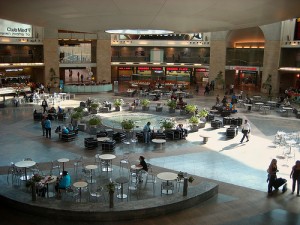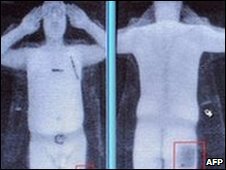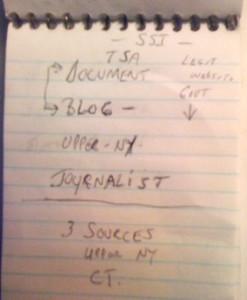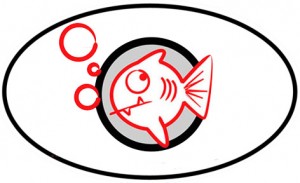
TSA badge
Fort Wayne International Airport is the latest airport to get the full-body scanners, which brings the total US airports to 23. I have not hidden my opinion that full-body scanners are a bad choice due to the fact that they violate a passenger’s privacy and can be easily avoided.
Last week a Transportation Security Administration (TSA) worker at Miami International Airport ended up being arrested, after a co-worker teased him about his genitals.
Rolando Negrin was being scanned as a training exercise when a co-worker started to repeatedly harass him for the size of his “manhood.” Witnesses say Negrin lost it and started to hit his co-worker with a police baton. Negrin could be heard saying in Spanish, “get on your knees or I will kill you and you better apoligise [sic].”
The TSA has a zero-violence policy and stated, “we are investigating to determine whether other officers may have violated procedures in a training session with coworkers and committed professional misconduct.”
The TSA likes to note that this incident was internal and did not involve the general public. However, we have already seen the body scanners abused in public once and as they are used more, I am sure we will see them abused again.
When scanning passengers, the TSA says that a screener views the live image in a remote location and the images will be permanently deleted, never being stored. However, in a letter to the Electronic Privacy Information Center (EPIC), the TSA states they have 2,000 test images stored, using TSA personal, at its test facility. This means that the system has the capability to store images, not to mention workers could sneak in cameras or phones.
EPIC has tried to gain access to the test images to see how privacy might be violated, but the TSA has refused to release them. EPIC has filed a lawsuit against the Department of Homeland Security under the Freedom of Information Act seeking details about the government’s use of advanced imaging technology. Many fear if the scans are publicly released, it will allow people to learn how to beat the system. Right now the system is really easy to beat, just refuse to be scanned and ask for a pat-down.
How much is all this wonderful security costing you, the tax payers? Only $6Billion per year. According to Stanford Daily, when airport security was still privatized in 2001, it only cost $700Million. Even in comparing with 2001 prices, that is $700million versus $4.6Billion.
It is frustrating to see stories like this continue to pop-up. I am sure this will not be the last story of a passenger’s rights being violated. Stay tuned…
Image: Tektum
connect | web | twitter | facebook |

Ben Gurion International Airport outside of Tel Aviv.
A few weeks ago I wrote a blog calling body scanners a “joke” and I was quite harsh on the Transportation Security Administration’s (TSA) decision to move forward with them.
Don’t get me wrong. I fly a lot. I like my life. I am all about protecting it and those who fly with me. But, I am not about the TSA wasting money for “security theater.”
After I posted my thoughts, the TSA posted a blog titled, “Advanced Imaging Technology – Yes, It’s Worth It.” It seem to be a rebuttal to those of us who have voiced concern about the TSA moving forward with the body scanners. However, TSA’s explanation is short on actual specifics of how the body scanners will stop someone from doing harm to airlines and passengers.
In my previous blog, my biggest issue was people could choose to avoid the scanners. If you didn’t want to be scanned, you could opt to get a pat down. For privacy reasons, it is great they offer this alternative, but for safety reasons it makes no sense. Why use all this pricey equipment, if someone who wants to do harm can just avoid it?
Their blog does a wonderful job explaining how these high-tech body scanners can pick up the smallest illegal items, but nothing about how scanners can be avoided or steps that are being taken to stop more privacy violations. I posted the question directly to the folks at TSA Blog, but never got a response, even though they did answer other people’s questions.
Over on my Seattle PI syndication I currently have 45 comments from readers who feel strongly (on both sides) about the body scanners. This shows me there are quite a few other people out there that have grave concerns about these scanners. I have been told a few times, “okay smart guy, how about stop just complaining and provide a solution” (okay, maybe not exactly like that, but you get the idea).
I would really hope someone out there with experience in air safety, could find a better solution. Talking to people about airport security I kept being told to check out out how Israel works their airport and airline security. So, I did and what I found looks like they might be on to something.
Isreal’s security allows for greater security, but less inconvience for travellers. And it must work. Tel Aviv’s Ben Gurion Airport, Israel’s larget hub, has not had a security breach since 2002.
“It is mindboggling for us Israelis to look at what happens in North America, because we went through this 50 years ago,” said Rafi Sela, the president of AR Challenges, a global transportation security consultancy, in an interview with TheStar.com. He’s worked with the RCMP, the U.S. Navy Seals and airports around the world. “Israelis, unlike Canadians and Americans, don’t take shit from anybody. When the security agency in Israel (the ISA) started to tighten security and we had to wait in line for not for hours but 30 or 40 minutes, all hell broke loose here. We said, ‘We’re not going to do this. You’re going to find a way that will take care of security without touching the efficiency of the airport.”
Their security is a multi-layer system:
LAYER 0: Intelligence
Before anyone even leaves for the airport, Isreal has strong intelligence network, trying to determine particular threats and dispose of them before they even reach the first layer.
LAYER 1: Roadside Check
Before you can even get to the airport, security stops every car and asks two questions, “How are you? Where are you coming from?” The answers aren’t nearly important, but more of how the person responds. Security officers are trained to detect nervousness and distress. Not the amount that a lot of people feel from flying, but those that occur when you are about ready to kill yourself and many others.
LAYER 2: Outside Guards
Armed guards are stationed outside the terminal and are trained to observe passengers. Any sort of odd behavior or strange baggage, you will be pulled aside for additional questioning and possible searches.
LAYER 3: Bag Inspections
Passengers that look suspicious or are just random will be pulled aside to be scanned by a metal detector and have their bags scanned.
LAYER 4: Ticket Agent Questions
Now, you have fully made it into the terminal. The ticket agent will take your documents and ask you a series of questions, the whole time, looking directly into your eyes, “which is very embarrassing. But this is one of the ways they figure out if you are suspicious or not. It takes 20, 25 seconds,” said Sela. Again, they are specially trained to detect body language that would show the person means to do harm. Also, passengers are not allowed to group up, which would provide a group target for a terrorist.
LAYER 5: Bag Termination
Let’s say a terrorist has made it through the first four layers of security and still is able to get his bomb to the ticket agent. Every bag is screened right away. If a bomb or suspicious material is found, they do not evacuate the whole terminal, like you would see in America. Evacuation causes panic, more targets, and a huge delay. Instead, scanners have bomb boxes near by and a suspected bag is put into the box, which can contain an explosion of up to 100 kilos of plastic explosives. People within a few meters of the suspected bomb need to be cleared and the rest of the airport is able to go through its normal business. “This is a very small simple example of how we can simply stop a problem that would cripple one of your airports,” Sela said.
LAYER 6: Body and Luggage Check
You would think this is like America’s security check, but Sela says, “Here it is done completely, absolutely 180 degrees differently than it is done in North America. First, it’s fast there’s almost no line. That’s because they’re not looking for liquids, they’re not looking at your shoes. They’re not looking for everything they look for in North America. They just look at you.”
All these layers have solid security, but they also get passengers from the parking lot to their gate in less than 25 minutes. Now, that is impressive. Sela feels the TSA could move in this direction, but they are on the wrong path. “Even today with the heightened security in North America, they will check your items to death. But they will never look at you, at how you behave. They will never look into your eyes … and that’s how you figure out the bad guys from the good guys.”
Yes, this is profiling, but I think it is the good kind of profiling. Racial profiling = wrong, behavior profiling = right. Sela said, “To us, it doesn’t matter if he’s black, white, young or old. It’s just his behaviour. So what kind of privacy am I really stepping on when I’m doing this?”
Do the Israelis have a good security system? I think so, but I don’t think it could easily be used the exact same way in America. We definitely don’t do well with seeing people with large guns walking around and this system would be vulnerable to racial profiling. I do think looking at behavior profiling would be a better use of resources than spending money on machines that people can skip all together.
Sources: TheStar.com & Vancouver Sun Image: iamxande
connect | web | twitter | facebook |

Image from a body scan
From the beginning I have been against airport body scanners. Not only because of the privacy aspect, but they just don’t work effectively. I have been watching closely the development of the body scanners, which are starting to be used around the world, and problems are already popping up.
Probably the biggest issue is that the body scanners can easily be avoided. Stephen Frischling recently looked how even the very best security is no good, if someone wanting to do harm can just circumvent it.
Kathleen Petrowsky, the Transportation Security Administration’s (TSA) Director at Chicago O’Hare Airport, first stated it would be mandatory for all passengers to be scanned with the body scanners. However, after making that statement, Frishling received a reply from the TSA’s blog team stating, “Imaging technology is optional. No plans to make it mandatory’¦ Anything else you read is incorrect.” Frischling confirmed this with the TSA’s Public Affairs unit that the scanners would be optional. Passengers who do not want to be scanned would be able to have a pat down instead.
Hmm. We are told that pat downs are not affective enough at stopping terrorists; so we need the body scanners, yet they are not required? What would stop someone who wanted to do harm to request a pat down? Not to get too graphic but there are a lot of places someone could hide something they don’t want found. At about $150,000.00 a pop is this really a good investment?
Does this mean I am advocating the body scanners be required? No way! Putting the fact you can avoid them aside, there is still the issue of privacy. JetBlue’s BlueTales blog recently reported about a security agent who made a sexually charged remark about a passenger who accidentally walked through a body scanner at London Heathrow Airport. He stated, “love those gigantic ****” (click here for the actual wording) when the 29 year old female passenger walked through.
The machines are designed well and they do a good job. The weak part are the people. Don’t get me wrong, the majority of TSA workers are great workers and do a wonderful job. But you only need a few people to screw up a whole process. Yes, in America the TSA will be in a remote location reviewing the scanner images so passengers won’t have to hear if they make any inappropriate comments.
I really think it has to do more with security theater than anything else. It costs a lot of money, we are already seeing the privacy issues and it can be avoided all together, so what is the point? If passengers don’t feel safe, they won’t fly. These machines make most passengers feel safe even though in reality they aren’t any safer. Is it more important to spend money on safety you can see or safety that works?
Image: BBC
connect | web | twitter | facebook |

One of the many pages of the TSA agent's notepad. Pic from RunwayGirl
Remember back when the TSA harassed another aviation blogger about a leaked TSA directive? I didn’t think the story could have gotten any crazier, but I was wrong.
Mary Kirby (RunwayGirl) was given photos, from a very reliable source, of a notebook that was dropped by the TSA agent who paid a visit to Steven Frischling (FlyingwithFish) a few days ago.
The source and Kirby are keeping quiet on all the information in the notebook (since they don’t want a visit from the TSA), but Kirby assures me this is not something the TSA would want in the public realm. Asked if she has prepared for her own visit from the TSA Kirby responded, “as any other Irish-American would do, I cleaned my house and made sure I had plenty of teabags at the ready. I’m happy to report that the TSA has not paid me a visit. I guess that means more tea for me.” Hopefully it stays that way.
I have been in contact with Kirby over the past two and a half days since she first posted about the mishap. She has been emailing and calling the TSA, but no one will respond. “I have made several requests for comment to the TSA, both via telephone and email. I have not received a response,” Kirby frustratedly told me.
Why did the TSA care so much about who leaked one of their very public directives, but doesn’t seem to give a darn about a notebook that the TSA agent dropped? Are they hoping this will go away? Kirby thinks so, “it is my best guess that the TSA has decided to say nothing in hopes that this blog story simply goes away.” So far it doesn’t seem it will. Quite a few media sources have already picked up on this and people want answers.
A good aviation friend mentioned to me that the TSA is coming across like a mixture of the three stooges and the mafia. Trying to be strong armed, trying to do the right thing, but doing both poorly. I really pride my blog with trying to stay positive with all aspects of aviation, but the TSA is making it VERY hard recently.
I asked Kirby who should people contact to voice their concern. Since she has had little luck getting a hold of someone her best advice was to write to the TSA Blog through their Twitter account. Hopefully we will all hear from the TSA soon, but since they haven’t even updated their own blog since December 26th, it seems communicating to the public is not a top priority for them.
UPDATE 9:30am: The TSA has emailed Kirby about the notebook. “In addition, a TSA investigator accidentally dropped a notebook, his personal property, in a public area. The notebook did not contain any sensitive security information; however, TSA will continue to review the incident.” Kirby has posted another image of the notebook since the TSA doesn’t feel it is a security breach.
More information:
* More TSA notebook photos via RunwayGirl
* TSA investigator has butterfingers via Gadling
* TSA Special Agent who threatened blogger spaces out, drops notebook in public place via BoingBoing
* Open letter from Frishling to the TSA about the notebook via FlyingwithFish
follow | web | twitter | email | rss |

Frischling is looking for some support. You can order one of these stickers by clicking on the photo or link in this blog
I got pretty obsessed with watching how the TSA subpoena story played out, I felt it was an important story and I am glad it got covered. I am working on a blog with a few people to talk about the power of Twitter with this story, but for now I just want to keep you updated.
The great news is the TSA backed down and withdrew the subpoena demanding Chris Elliott and Steven Frischling (FlyingWithFish) turn over any documents related to the TSA Directive 1544-09-06. What a great way to start a New Year!
If you were interested in this story too or have found that FlyingWithFish to have a pretty sweet blog, you can help! While the TSA had his laptop, the hard drive got errors. He is working to have them pay for the damages, but will need to pay someone to recover his files. Go to his website to order a cool FlyingWithFish sticker or just to donate some money. Chris Elliott also seeked counceal and needs needs our help. You can help Elliott via his website.
Additional information:
* Support Frischling (FlyingWithFish) by purchasing a Fish sticker!
* Elliott thanks all his supporters and still has kind words for the TSA agent that came to his house
* Frischling is happy that this seems to be over
* Judith Miller (who spent 85 days in jail for refusing to testify before a federal grand jury investigating a source) talks about the TSA withdrawing their subpoena
follow | web | twitter | email | rss |




